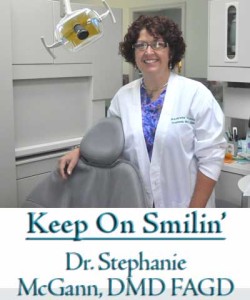It’s not always what you eat, but how you eat it
By Dr. Stephanie McGann, DMD FAGD, Columnist, UnionvilleTimes.com
 What we eat over the holidays matters. As the holidays are coming up fast I thought I would share some news on nutrition and dental health.
What we eat over the holidays matters. As the holidays are coming up fast I thought I would share some news on nutrition and dental health.
Pass the Cranberries.
A number of studies have been done recently on the health benefits of cranberries. Women have known for decades that cranberry juice can help prevent or lessen the severity of a urinary tract infection.
Now we know why.
Recent studies have been looking at cranberries and their effects on bacteria. It has been discovered that one of the natural compounds found in cranberries – proanthocyanidin (PAC) makes the bacteria less able to stick to tissue. Evidence suggested that women who drank cranberry juice with a urinary tract infection caused the bacteria to lose adhesion to the tissues and subsequently wash away.
What could this possibly have to do with dentistry?
A study in a Canadian dental journal has discovered that the same humble cranberry can reduce the adhesion of bacteria that cause gum disease and dental decay. These active compounds seem to make these bacteria unable to produce as many of the enzymes that contribute to gum disease. In addition the bacteria that produce acids that cause tooth decay are also compromised by the lowly cranberry.
A study at Rutgers University compared the action of PAC’s in cranberries to those in other foods such as grape and apple juice, dark chocolate and green tea. Cranberries seem to have more effective PAC’s than any other food source studies so far.
According to one study to get the maximum health benefits from cranberries you should have one serving in the morning and one in the evening.
Servings:
1 cup fresh or frozen cranberries
8oz glass of cranberry juice
1/3 cup cranberry sauce
1/3 cup dried sweetened cranberries
DISCLAIMER
A cranberry is a food, not a treatment. If an infection is suspected consult the appropriate health care provider.
Don’t Cranberries have sugars and acids?
Yes, cranberries alone do not a healthy diet make. They should be eaten as part of a meal or when drinking cranberry juice be sure to have it along with other foods such as cheese or grains that will reduce the acids in the mouth.
A healthy diet for the teeth is the same healthy diet rich in calcium and protein that protects dental enamel and provides for strong bones and muscles.
OK – I’m not the Grinch and I will no doubt be eating those amazing chocolate chip cookies that my husband makes. I will enjoy candy, chocolate, sweet desserts, and everything else that nutrition-conscious health care providers cringe at. (The secret fact is that during the month of December there are plenty of sugary snacks in the back rooms of every dental office)
How to eat sweet and eat smart:
- Sugar is not the enemy. Prolonged contact with sugary foods is. I tell my patients if you’re staring down a roll of lifesavers, from a dental perspective it’s way better to eat them all, then to suck one at a time all day long. Same calories, same sugar, but a lot less damaging to the teeth. The same is true for sugary drinks, the jumbo coke sipped all day long is a dental nightmare, but a coke that is consumed quickly is less of a dental problem.
- Just because it’s healthy doesn’t mean it’s ideal for your teeth. For example, raisins. As a mom I love to give my kids those cute little red boxes of raisins. Full of iron, and vitamins and all natural with no preservatives, no additives and oh yeah, they get stuck in the teeth and the natural sugars are just as bad. Brush after every box.
- Popcorn – it has it’s own diagnosis. For anyone who has had popcorn gingivitis, I’m sorry. Those rogue pieces of hull that work their way under the gum are annoying, but for some unlucky folks they can be extremely painful. On occasion the human body recognizes the little piece of hull and mounts a full blown foreign body response. OUCH. When in doubt. Floss. If it starts to look red and swell – call your dentist.
- Remember the dental safety foods, milk, cheese, meat, nuts and food that are high in calcium or protein will help diminish the effects of sugars and acids, subsequently reducing the risk of tooth decay.
- Xylitol, as artificial sweeteners go it has the most dental benefits and can actually help prevent decay. So if you’re looking for a breath mint or gum, choose one sweetened with xylitol.
- When in doubt, more cranberries.
So happy holidays to all
And pass the cranberry sauce please!
Dr. Stephanie McGann is a resident of the Unionville area and along with her partner, Dr. Marie Scott, operates The Brandywine Smile Center, a family-friendly dental practice in Concordville. She is a Fellow of the Academy of General Dentistry.






Trackbacks